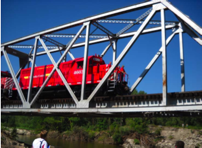NUCOR STEEL: TRANSPORTATION RECOVERY THROUGH SYSTEMS SAVVY MANAGEMENT
/Nucor is the largest producer of steel in the U.S. and the world's foremost steel recycler. In June of 2010 the Norfolk, Nebraska area, home to four Nucor divisions, was struck by horrible flooding. This is Part 3 of their story and how we can see systems savvy woven into their tightly aligned practices (Part 1, Part 2).
Dirk Petersen (General Manager of the Nucor Steel plant in Norfolk, Nebraska) and Troy Brooks (Sales / Shipping Manager) were returning from a business trip on June 15. As they transferred at Chicago's Midway airport, Troy got a call from Mark Eichberger, the Rail and Scrap Supervisor, that the railroad bridge had gone out. Normally, approximately 20 percent of the scrap they use to make their steel comes in by rail, as well other materials like coal and lime. Fifty percent of their finished product goes out by rail. The rail link would be down for two months. Dirk: "The goal from Day 1: take care of customers safely."
When they got back to the site they joined in the ongoing weaving together of technology and organizational practices. Transloading, the movement of truck to rail and vice versa, was the key technology at play. Everyone knew they had to find ways to shift the rail transportation to trucking, quickly, and without letting shipping costs go higher than necessary.
While Nucor Steel's computer inventory systems could handle the shift from rail to truck, the physical movement of the materials required quick, safe, but large-scale, engineering and construction. Transloading sites were established on the other side of the river. This included bringing in a 60-foot wide gantry crane from Arizona and the creation of new roads to support the transloading (and the bridge repair).
Dirk described the process as being about the relationships. The daily meetings with local officials and stakeholders were about "making sure everybody knew what everybody else was doing and how they were accountable." Basically, bringing all the actors into the Nucor approach I've described in the last two posts (here & here). Long-standing relationships and the ability to reach quick agreements were key to their success. Sister companies, customers, vendors, local and federal government all came together to push forward the massive construction process and shift in operational strategy. Many were proactive in their offers to help.
- Permits were granted - collaboration with local and federal government
- Shipping hours were increased - collaboration with vendors and customers
- The local road closed to all but company business - collaboration with local government
- A second gate was added - collaboration with vendors
Those most knowledgeable in the particular areas stepped up and managed the weaving. Because these companies had tight relationships before the flood, they had good understandings of each others' needs and abilities. Dirk summarized the can-do attitude that supported the work:
We just knew we had to do it. We knew we could do it. We didn't hesitate to do it. Focus on taking care of the customer -- safely, [especially given this was an] out of the ordinary activity.
The deep relationships meant things could happen when they needed to happen. I believe trust also played a role in that, given the relationships and knowledge of the Nucor approach, the customers and vendors knew good decisions would be made. Neither Nucor Steel nor Vulcraft is passing along the increased transportation costs to their customers . . . continuing to support these deep relationships. Result, "We never missed one beat due to lack of scrap [their main raw material] and our scrap inventory actually grew in the last two months" (from Dirk's Green Sheet letter to employees, Aug, 2010). Look for Part 4 on Monday.







